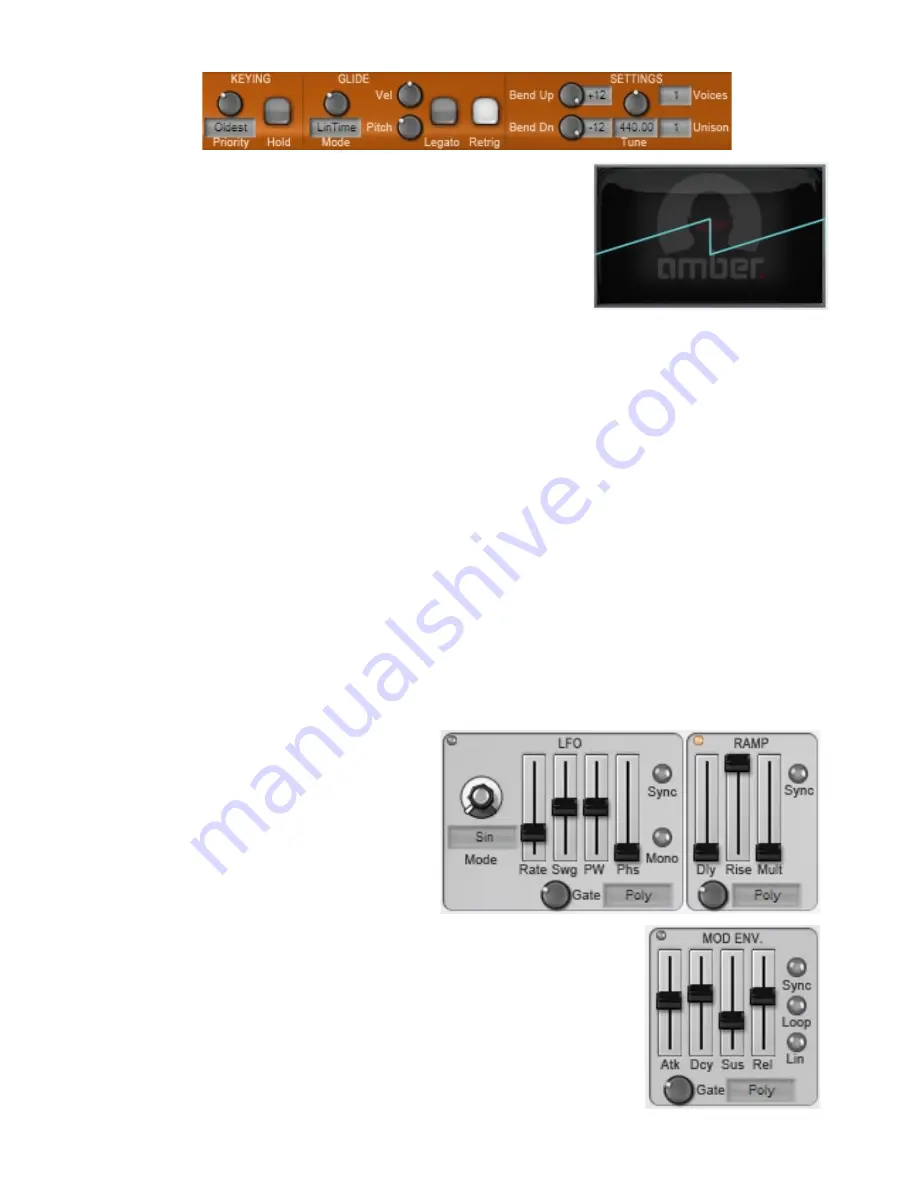
40
5:8 Other functions
Settings, Glide and Keying controls
These parameters are included in all DCAM: Synth Squad synths, and are
described in sections 6:2, 6:3 and 6:4.
Visualizer scope
The visualizer scope provides context-sensitive graphical feedback for each
section of Amber. See section 6:6 for more details on this feature.
5:9 Modulation
The TransMod system must be used for all programmed modulation in Amber.
With the exception of the Synth and Ensemble Envelopes (directly routed internally to the individual paraphonic
Synth and Ensemble notes’ VCAs) and the non-adjustable keytracking for the paraphonic 1-pole tone filters, none of
Amber’s modulators have direct routings to any parameters. There are no controls for setting the depth of internal direct
modulation.
Paraphonic architecture and polyphonic modulation
Amber’s divide-down synthesis architecture is very different from the conventional polyphonic architecture of Strobe and
Cypher, meaning that modulation must also be approached differently. In polyphonic (or monophonic) architectures, a
modulator such as an LFO acts per voice – each voice is shaped by the modulator polyphonically. In other words, each
voice has its own LFO operating independently of the other voices’ LFOs.
Amber’s divide-down ‘paraphonic’ architecture means that one voice actually generates all notes on the keyboard within
a single voice. This paraphonic portion of the synth actually contains 192 envelopes and VCAs – one for each note it can
produce in the Synth and Ensemble sections.
However, the voice also contains elements that feature a single instance for every voice – LFO, Ramp and ModEnv
modulators, and the multi-mode resonant filter, formant filter, chorus and Mixer/Amplifier stages in the signal path. These
elements all act polyphonically (monophonically for each voice) rather than paraphonically. Similarly, the TransMod system
also acts polyphonically.
It is therefore necessary to disassociate the concepts of ‘more than one note at a time’ and ‘polyphony’ – when using
Amber in conventional 1-voice mode, the polyphonic elements act monophonically as only a single voice is active.
In order to achieve different modulation values on different notes, you must use multiple voices and suitable TransMod
modulation.
The Synth and Ensemble envelopes are special cases (see below for further details).
Gateable modulators
Gateable modulators (which actually can be gated with
note-on/note-off or triggered with note-on) feature a
number of different gating/triggering modes, including
the ability to gate or trigger each other. For more
details, see section 7:5.
LFO
Gateable by: Poly, PolyOn, Mono, Ramp, ModEnv,
Song
Ramp
Gateable by: Poly, PolyOn, Mono, LFO, ModEnv, Song
Mod Envelope
Gateable by: Poly, PolyOn, Mono, LFO, Ramp, Song
Содержание DCAM SYNTH SQUAD
Страница 1: ......
Страница 2: ......
Страница 26: ...26 Shaper Filter Amp sections...
Страница 109: ......
Страница 110: ......
















































